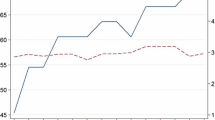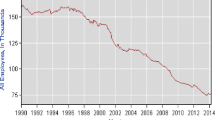Abstract
This paper derives welfare equivalence of double taxation rules in a tax competition model with discriminatory home taxes and the ability to finance subsidiary operations with host country capital. For a more general model, we provide sufficient conditions on the number of host sectors and factors that support double-tax-rule equivalence. Examples violating these conditions help identify economic factors under which a home country has strict preferences over double taxation rules. If the home tax rate can influence host factor prices, the home country weakly prefers deductions over credits as in the pure-home-equity financing case.
Similar content being viewed by others
References
Altshuler, R. and J. Mintz. (1995). “U.S. Interest-Allocation Rules: Effects and Policy.” International Tax and Public Finance 2, 7-35.
Barnea, A., R. Haugen and L. Senbet. (1985). Agency Problems and Financial Contracting, Prentice-Hall: Englewood-Cliffs Publishers.
Bhagwati, J., A. Panagariya and T. N. Srinivasan. (1998). Lectures on International Trade, 2nd edition. Cambridge: The MIT Press.
Bond, E. and L. Samuelson. (1989). “Strategic Behaviour and the Rules for International Taxation of Capital.” Economic Journal 99, 1099-1111.
Calvo, G. and S.Wellisz. (1983). “International Factor Mobility and National Advantage.” Journal of International Economics 14, 103-114.
Caves, R. (1996). Multinational Enterprise and Economic Analysis, 2nd ed. Cambridge University Press.
Collins, J. and D. Shackelford. (1992). “Foreign Tax Credit Limitations and Preferred Stock Issuances.” Journal of Accounting Research 30, 103-124.
Feldstein, M. (1994a). “Taxes, Leverage, and the National Return on Outbound Foreign Direct Investment.” NBER Working Paper No. 4689.
Feldstein, M. (1994b). “Tax Policy and International Capital Flows.” NBER Working Paper No. 4851.
Feldstein, M. (1995). “The Effects of Outbound Foreign Direct Investment on the Domestic Capital Stock.” In Martin Feldstein, James Hines, Jr. and R. Glenn Hubbard (eds.), The Effects of Taxation on Multinational Corporations. University of Chicago Press.
Feldstein, M. and D. Hartman. (1979). “The Optimal Taxation of Foreign Source Investment Income.” Quarterly Journal of Economics 93, 613-629.
Feldstein, M. and C. Horioka. (1980). “Domestic Saving and International Capital Flows.” Economic Journal 90, 314-329.
Froot, K. and J. Hines, Jr. (1995). “Interest Allocation Rules, Financing Patterns, and the Operations of U.S. Multinationals.” In Martin Feldstein, James Hines Jr. and R. Glenn Hubbard (eds.), The Effects of Taxation on Multinational Corporations. University of Chicago Press.
Gordon, R. (1992). “Can Capital Income Taxes Survive in Open Economies?” The Journal of Finance 67, 1159-1180.
Hamada, K. (1966). “Strategic Aspects of Taxation on Foreign Investment Income.” Quarterly Journal of Economics 80, 361-375.
Hartman, D. (1985). “Tax Policy and Foreign Direct Investment.” Journal of Public Economics 26, 107-121.
Hines, J. Jr. (1988). “Taxation and U.S. Multinational Investment.” In Lawrence Summers (ed.), Tax Policy and the Economy. MIT Press.
Hines, J. Jr. (1994). “Credit and Deferral as International Investment Incentives.” Journal of Public Economics 55, 323-347.
Horst, T. (1977). “American Taxation of Multinational Firms.” American Economic Review 67, 376-389.
Howenstine, N. and W. Zeile. (1994). “Characteristics of Foreign-Owned U.S. Manufacturing Establishments.” Survey of Current Business 74, 34-59.
Janeba, E. (1995). “Corporate Income Tax Competition, Double Taxation Treaties, and Foreign Direct Investment.” Journal of Public Economics 56, 311-325.
Jenkins, R. (1990). “Comparing Foreign Subsidiaries and Local Firms in LDCs: Theoretical Issues and Empirical Evidence.” Journal of Development Studies 26, 205-228.
Jensen, M. and W. Meckling. (1976). “Theory of the Firm: Managerial Behavior, Agency Costs and Ownership Structure.” Journal of Financial Economics 3, 305-360.
Jones, R. and I. Coelho. (1985). “International Factor Movements and the Ramaswami Argument.” Economica 52, 359-364.
Jones, R., I. Coelho and S. Easton. (1986). “The Theory of International Factor Flows: The Basic Model.” Journal of International Economics 20, 313-327.
Leechor, C. and J. Mintz. (1993). “On the Taxation of Multinational Corporate Investment when the Deferral Method is Used by the Capital Exporting Country.” Journal of Public Economics 51, 75-96.
Newlon, T. S. (1987). “Tax Policy and the Multinational Firm's Financial Policy and Investment Decisions.” Unpublished Ph.D. dissertation, Princeton University.
Osterberg, W. (1989). “Tobin's q, Investment, and the Endogenous Adjustment of Financial Structure.” Journal of Public Economics 40, 293-318.
Ramaswami, V. (1968). “International Factor Movement and the National Advantage.” Economica 35, 309-310.
Razin, A., E. Sadka and C.-w. Yuen. (1998). “A Pecking Order of Capital Inflows and International Tax Principles.” Journal of Public Economics 44, 45-68.
Rybczynski, T. (1955). “Factor Endowments and Relative Commodity Prices.” Economica 22, 336-341.
Stevens, G. and R. Lipsey. (1988). “Interactions between Domestic and Foreign Investment.” International Finance Discussion Papers No. 329, Board of Governors of the Federal Reserve System.
U.S. Department of Commerce. (1992). 1989 Benchmark Survey of U.S. Investment Abroad. U. S. Government Printing Office: Washington D.C.
Wilson, J. (1987). “Trade, Capital Mobility, and Tax Competition.” Journal of Political Economy 95, 835-856.
Wilson, G. P. (1993). “The Role of Taxes in Location and Sourcing Decisions.” In Alberto Giovannini, R. Glenn Hubbard and Joel Slemrod (eds.), Studies in International Taxation. University of Chicago Press.
Zebregs, H. (1998). “Can the Neoclassical Model Explain the Distribution of Foreign Direct Investment Across Developing Countries?” International Monetary Fund Working Paper No. WP/98/193.
Author information
Authors and Affiliations
Rights and permissions
About this article
Cite this article
Davies, R.B., Gresik, T.A. Tax Competition and Foreign Capital. International Tax and Public Finance 10, 127–145 (2003). https://doi.org/10.1023/A:1023381705984
Issue Date:
DOI: https://doi.org/10.1023/A:1023381705984




